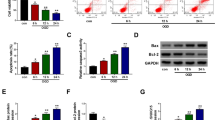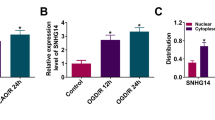Abstract
Ischemia stroke is one of the leading causes of death and disability in the world. Long non-coding RNA ANRIL has been reported to play an important role in ischemic injury. In this study, we aim to explore the mechanism by which ANRIL exhibits protective effect. Middle cerebral artery occlusion mouse models were applied and infarction areas were assessed by TTC assay. The expression of ANRIL and miR-199a-5p were determined by qPCR. Oxygen and glucose deprivation treatment was applied to mimic in vitro ischemia injury in N-2a cells. The levels of BCL-2, BAX, MEK, ERK, CAV-1 were determined by western blot. Cell viability were assessed by MTT assay. The direct interaction among miR-199a-5p and ANRIL, miR-199a-5p and CAV-1 were demonstrated by dual Luciferase report assay. ANRIL and miR-199a-5p expression were changed in both in vivo and in vitro ischemia model. Overexpression of ANRIL or inhibition of miR-199a-5p could protect cells against ischemia induced injury by elevating cell viability through CAV-1 mediated MEK/ERK pathway. miR-199a-5p attenuated CAV-1 expression by direct targeting. ANRIL competitively interacted with miR-199a-5p in N-2a cells, leading to a de-repression of CAV-1. ANRIL protects N-2a cells against ischemia induced injury by elevated CAV-1 by competitively interacting with miR-199a-5p, thus activating MEK/ERK pathway and elevating cell viability.







Similar content being viewed by others
References
Beal CC (2010) Gender and stroke symptoms: a review of the current literature. J Neurosci Nurs 42:80–87
Bushnell CD (2008) Stroke and the female brain. Nat Clin Pract Neurol 4:22–33
Chen PH, Gao S, Wang YJ, Xu AD, Li YS et al (2012) Classifying ischemic stroke, from TOAST to CISS. CNS Neurosci Ther 18:452–456
Xin JW, Jiang YG (2017) Long noncoding RNA MALAT1 inhibits apoptosis induced by oxygen-glucose deprivation and reoxygenation in human brain microvascular endothelial cells. Exp Ther Med 13:1225–1234
Zhang X, Tang X, Liu K, Hamblin MH, Yin KJ (2017) Long noncoding RNA Malat1 regulates cerebrovascular pathologies in ischemic stroke. J Neurosci 37:1797–1806
Yan H, Yuan J, Gao L, Rao J, Hu J (2016) Long noncoding RNA MEG3 activation of p53 mediates ischemic neuronal death in stroke. Neuroscience 337:191–199
Wu Z, Wu P, Zuo X, Yu N, Qin Y et al (2017) LncRNA-N1LR enhances neuroprotection against ischemic stroke probably by inhibiting p53 phosphorylation. Mol Neurobiol 54:7670–7685
Zhang L, Luo X, Chen F, Yuan W, Xiao X et al (2018) LncRNA SNHG1 regulates cerebrovascular pathologies as a competing endogenous RNA through HIF-1alpha/VEGF signaling in ischemic stroke. J Cell Biochem 119:5460–5472
Zhang B, Wang D, Ji TF, Shi L, Yu JL (2017) Overexpression of lncRNA ANRIL up-regulates VEGF expression and promotes angiogenesis of diabetes mellitus combined with cerebral infarction by activating NF-kappaB signaling pathway in a rat model. Oncotarget 8:17347–17359
Feng L, Guo J, Ai F (2019) Circulating long noncoding RNA ANRIL downregulation correlates with increased risk, higher disease severity and elevated pro-inflammatory cytokines in patients with acute ischemic stroke. J Clin Lab Anal 33:e22629
Liu B, Cao W, Xue J (2019) LncRNA ANRIL protects against oxygen and glucose deprivation (OGD)-induced injury in PC-12 cells: potential role in ischaemic stroke. Artif Cells Nanomed Biotechnol 47:1384–1395
Ni J, Wang X, Chen S, Liu H, Wang Y et al (2015) MicroRNA let-7c-5p protects against cerebral ischemia injury via mechanisms involving the inhibition of microglia activation. Brain Behav Immun 49:75–85
Zhao H, Wang J, Gao L, Wang R, Liu X et al (2013) MiRNA-424 protects against permanent focal cerebral ischemia injury in mice involving suppressing microglia activation. Stroke 44:1706–1713
Zuo Y, Wang Y, Hu H, Cui W (2016) Atorvastatin protects myocardium against ischemia-reperfusion injury through inhibiting miR-199a-5p. Cell Physiol Biochem 39:1021–1030
Xu WH, Yao XY, Yu HJ, Huang JW, Cui LY (2012) Downregulation of miR-199a may play a role in 3-nitropropionic acid induced ischemic tolerance in rat brain. Brain Res 1429:116–123
Xu ST, Xu JH, Zheng ZR, Zhao QQ, Zeng XS et al (2017) Long non-coding RNA ANRIL promotes carcinogenesis via sponging miR-199a in triple-negative breast cancer. Biomed Pharmacother 96:14–21
Zhang PX, Cheng J, Zou S, D'Souza AD, Koff JL et al (2015) Pharmacological modulation of the AKT/microRNA-199a-5p/CAV1 pathway ameliorates cystic fibrosis lung hyper-inflammation. Nat Commun 6:6221
Xu L, Wang L, Wen Z, Wu L, Jiang Y et al (2016) Caveolin-1 is a checkpoint regulator in hypoxia-induced astrocyte apoptosis via Ras/Raf/ERK pathway. Am J Physiol Cell Physiol 310:C903–910
Kortum RL, Fernandez MR, Costanzo-Garvey DL, Johnson HJ, Fisher KW et al (2014) Caveolin-1 is required for kinase suppressor of Ras 1 (KSR1)-mediated extracellular signal-regulated kinase 1/2 activation, H-RasV12-induced senescence, and transformation. Mol Cell Biol 34:3461–3472
Liu P, Ying Y, Anderson RG (1997) Platelet-derived growth factor activates mitogen-activated protein kinase in isolated caveolae. Proc Natl Acad Sci USA 94:13666–13670
Li W, Huang R, Shetty RA, Thangthaeng N, Liu R et al (2013) Transient focal cerebral ischemia induces long-term cognitive function deficit in an experimental ischemic stroke model. Neurobiol Dis 59:18–25
Lin L, Su Z, Lebedeva IV, Gupta P, Boukerche H et al (2006) Activation of Ras/Raf protects cells from melanoma differentiation-associated gene-5-induced apoptosis. Cell Death Differ 13:1982–1993
Head BP, Patel HH, Tsutsumi YM, Hu Y, Mejia T et al (2008) Caveolin-1 expression is essential for N-methyl-D-aspartate receptor-mediated Src and extracellular signal-regulated kinase 1/2 activation and protection of primary neurons from ischemic cell death. FASEB J 22:828–840
Yin XM, Luo Y, Cao G, Bai L, Pei W et al (2002) Bid-mediated mitochondrial pathway is critical to ischemic neuronal apoptosis and focal cerebral ischemia. J Biol Chem 277:42074–42081
Pasmant E, Laurendeau I, Heron D, Vidaud M, Vidaud D et al (2007) Characterization of a germ-line deletion, including the entire INK4/ARF locus, in a melanoma-neural system tumor family: identification of ANRIL, an antisense noncoding RNA whose expression coclusters with ARF. Cancer Res 67:3963–3969
Tan P, Guo YH, Zhan JK, Long LM, Xu ML et al (2019) LncRNA-ANRIL inhibits cell senescence of vascular smooth muscle cells by regulating miR-181a/Sirt1. Biochem Cell Biol 97(5):571–580
Lu Y, Zhou X, Xu L, Rong C, Shen C et al (2016) Long noncoding RNA ANRIL could be transactivated by c-Myc and promote tumor progression of non-small-cell lung cancer. Onco Targets Ther 9:3077–3084
Amouyel P (2012) From genes to stroke subtypes. Lancet Neurol 11:931–933
Consortium CAD, Deloukas P, Kanoni S, Willenborg C, Farrall M, et al. (2013) Large-scale association analysis identifies new risk loci for coronary artery disease. Nat Genet 45: 25–33
Cunnington MS, Santibanez Koref M, Mayosi BM, Burn J, Keavney B (2010) Chromosome 9p21 SNPs associated with multiple disease phenotypes correlate with ANRIL expression. PLoS Genet 6:e1000899
Zhang W, Chen Y, Liu P, Chen J, Song L et al (2012) Variants on chromosome 9p21.3 correlated with ANRIL expression contribute to stroke risk and recurrence in a large prospective stroke population. Stroke 43:14–21
Parton RG, del Pozo MA (2013) Caveolae as plasma membrane sensors, protectors and organizers. Nat Rev Mol Cell Biol 14:98–112
Huang Q, Zhong W, Hu Z, Tang X (2018) A review of the role of cav-1 in neuropathology and neural recovery after ischemic stroke. J Neuroinflammation 15:348
Fu S, Gu Y, Jiang JQ, Chen X, Xu M et al (2014) Calycosin-7-O-beta-D-glucoside regulates nitric oxide /caveolin-1/matrix metalloproteinases pathway and protects blood-brain barrier integrity in experimental cerebral ischemia-reperfusion injury. J Ethnopharmacol 155:692–701
Acknowledgements
This work was supported by National Natural Science Foundation of China (Grant No. 81271298).
Author information
Authors and Affiliations
Corresponding author
Ethics declarations
Conflict of interest
We declare that we have no conflict of interests.
Additional information
Publisher's Note
Springer Nature remains neutral with regard to jurisdictional claims in published maps and institutional affiliations.
Electronic supplementary material
11064_2019_2951_MOESM1_ESM.tif
Supplementary file 1 Figure S1 Screening of putative ANRIL targeted miRNAs by Luciferase assay in 293t cells. Luciferase activity was detected 48 hours after indicated transfection. F=14.95. Date were shown as Mean ± SD based on three independent experiment. *p < 0.05, **p < 0.01. (TIF 9756 kb)
11064_2019_2951_MOESM2_ESM.tif
Supplementary file 2 Figure S2 Comparison of ANRIL effects in 12 hours and 24 hours OGD-treated N-2a cells. Cell viability of N-2a cells was measured by MTT assay after indicated treatment. F=22.91. Date were shown as Mean ± SD based on three independent experiment. *p < 0.05, **p < 0.01. (TIF 11046 kb)
Rights and permissions
About this article
Cite this article
Zhong, W., Li, YC., Huang, QY. et al. lncRNA ANRIL Ameliorates Oxygen and Glucose Deprivation (OGD) Induced Injury in Neuron Cells via miR-199a-5p/CAV-1 Axis. Neurochem Res 45, 772–782 (2020). https://doi.org/10.1007/s11064-019-02951-w
Received:
Revised:
Accepted:
Published:
Issue Date:
DOI: https://doi.org/10.1007/s11064-019-02951-w




